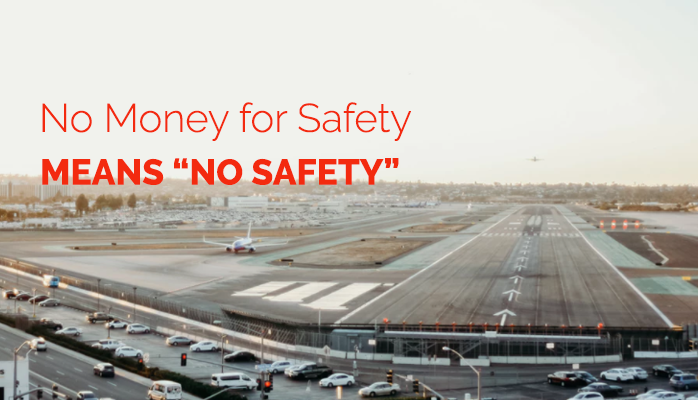What Are the Best Practices for Establishing Safety Accountabilities?

One of the first steps in implementing an aviation safety management system (SMS) is to complete the documentation elements in the Safety Policy and Objectives component of an ICAO compliant SMS.
Please note that I said "one of the first steps." Before tackling these documentation elements, we recommend that you first:
- Acquire top management support;
- Evaluate organizational goals and available resources to ensure SMS goals are realistic and align with organizational goals;
- Perform a gap analysis to determine which SMS elements already exist at your company, and next
- Create an SMS implementation plan, complete with activities and targeted start and finish dates.
Related Aviation SMS Implementation Articles
- Why Should We Implement Aviation SMS?
- How to Create Aviation SMS Implementation Plan - With Templates
- SMS First Steps - How to Create an SMS Implementation Plan
The reason we recommend the gap analysis and SMS implementation plan is to:
- Educate safety team as to SMS requirements and best practices; and
- Save time and energy by not having to drastically rework your SMS documentation.
The purpose of this article is to save safety managers time and money during:
- SMS implementation; and
- Regular review of SMS documentation requirements.
We also hope to shed some light on some best practices revolving around safety accountabilities in aviation SMS.
What Is Safety Accountability?
First, let's define accountability, which is especially useful for those who speak English as their second language. "Accountability" is the fact or condition of being accountable. Synonyms include responsibility, liability, and answerability.
According to ICAO guidance in the Safety Management Manual (bold added):
"The service provider shall identify the accountable executive who, irrespective of other functions, shall have ultimate responsibility and accountability, on behalf of the organization, for the implementation and maintenance of the SMS. The organization shall also identify the accountabilities of all members of management, irrespective of other functions, as well as of employees, with respect to the safety performance of the SMS. Safety responsibilities, accountabilities, and authorities shall be documented and communicated throughout the organization, and shall include a definition of the levels of management with authority to make decisions regarding safety risk tolerability."
I added the bold to emphasize the most important elements of this paragraph.
The accountable executive has ultimate responsibility for implementation and maintenance of the aviation SMS.
Establishing an accountable executive is an easy requirement to satisfy. Accountable executives are usually a:
- Chief executive officer;
- Chief operation officers
- Chairman of the board of directors;
- Partner; or
- Principal.
The important takeaway here is that there is only one! This is where the buck stops! One cannot share the ultimate responsibility with another, there can never be an "ultimate responsibility" assigned.
Related Articles on Accountabilities in Aviation SMS
- 5 Steps to Define Accountabilities in Aviation SMS
- Distinguishing Between Responsibility, Authority, and Accountability in Your Aviation SMS
- FAA Part 5 - Danger in Safety Accountability & Authority in Aviation SMS
Accountable Executive's Authorities and Responsibilities
According to ICAO's guidance material in Document 9859, the accountable executive's authorities and responsibilities include:
- Full authority for human resources issues;
- Authority for major financial issues;
- Direct responsibility for the conduct of the organization's affairs;
- Final authority over operations under its certificate/ approval;
- Establishment and promotion of the safety policy;
- Establishment of the organization's safety objectives and safety targets;
- Acting as the organization's safety champion; and
- Having final responsibility for the resolution of all safety issues.
Managing safety costs money. No money, no safety.

In every organization, managers control the allocation of resources, including financial, technical, and personnel. Withholding resources are the first indicator that top management is not fully committed to the SMS. Resources are required to mitigate safety risks when hazards manifest themselves and threaten the capabilities of aviation service providers.
The bottom line is that no top management commitment means that no money comes, which leads to the failure of aviation SMS.
Don't assume that inadequate safety budgets are attributed solely to a lack of top management support. There are limits to both:
- Organizational budgets; and
- Ability to generate revenue.
Smaller companies obviously have smaller budgets. Furthermore, smaller companies don't have the same scale of access to markets to attract customers and generate revenue to pay for necessary expenses.
Safety managers must not become disillusioned with management when they withhold budgets. Before asking for aviation SMS budgets, safety managers must first analyze both:
- organizational goals (not simply organizational safety goals); and
- existing resources in the company (both financial, manpower, tools).
Organizational goals and available resources must align with the SMS. It makes no business sense to spend extra money on aviation SMS implementation when there is an unrealistic expectation that "we are implementing an SMS because it's the right thing to do and keep everyone safe" versus the argument "we're implementing SMS because we expect to see these benefits."
Show management the value of the SMS, but don't expect everyone to be ecstatic about the SMS implementation. Aviation SMS involves the entire organization. This means:
- More work for departmental managers;
- Smaller budgets as SMS budget competes with operational budgets.
In short, safety managers will be competing with other managers for limited budgets and some will resent the SMS implementation as another hurdle to jump through that contributes very little to the bottom line.
Related Articles
- Tips to Increase Aviation SMS Budgets - for Safety Managers
- Why Aviation Safety Managers Fail Without Dept Head Support in SMS
- 3 Tips to Discover Resistance to Aviation SMS - With Checklists
Also, identify the accountabilities of all members of management and all employees.

SMS-related accountabilities, authorities, and responsibilities of key safety personnel will need to be fully documented and communicated throughout the organization. One must also not overlook the safety responsibilities of line employees and contractors.
This documentation usually takes the form of two sections of an ICAO-compliant SMS, namely:
- Organizational chart; and
- Duties and responsibilities of key safety personnel
Duties and responsibilities of key safety personnel are usually stored in one or more of the following:
- Safety manuals;
- Operations manuals;
- Web-based content accessible to all employees; or
- Stand-alone documents housed in SMS documentation.
As safety managers begin aviation SMS implementations, they struggle to understand what are the documentation requirements. What do they look like? Don't worry, this is common with other artifacts found in the SMS, including:
- safety policy;
- non-punitive reporting policy;
- list of key performance indicators;
- hazard register;
- safety goals and objectives, etc.
Safety managers could struggle for weeks to get the correct verbiage to display to the organization. If you are left scratching your head, I have some simple advice: "Don't make a science out of this." Grab a copy of another SMS' description of accountabilities, responsibilities, and authorities. Make sure you review the copied documentation to ensure it aligns with your safety culture and management's vision.
As long as you don't have another company's name in your documentation, then you shouldn't worry much about SMS auditor scrutiny in this area. Besides assigning the accountable executive to the SMS, safety accountabilities is perhaps the second easiest task faced by safety managers as they implement the SMS.
This is not to say that you should do shoddy work. This is an important task as it shapes the organization's safety culture and attitude toward SMS. Even when you have a "paper SMS" that merely checks the box, don't do a sloppy job with safety accountabilities, as this sets the tone of how management views the SMS.
A paper SMS may fit into current organizational goals. The accountable executive may have plans to "shift the needle" in a positive direction when more resources become available. What I'm trying to say is that it is easier to go from 60 mph to 120 mph than from a standstill to 120 mph.
Treating safety accountabilities and responsibilities seriously at the beginning of the SMS implementation will hopefully get you to 60 mph. As resources become available or management's organizational goals and attitudes change, your safety culture will not be stuck at a "standstill."
Related Aviation Safety Culture Articles
- What Is Safety Culture in the Aviation Industry?
- 6 Types of Safety Culture in Aviation Safety Management System
- Examples How to Improve Safety Culture in Aviation SMS - With Resources
Demonstrating Compliance
In order to demonstrate compliance, aviation service providers must show the existence of clear lines of safety accountabilities throughout their operations.
These accountabilities include:
- An accountable person owning ultimate accountability for the SMS;
- Management support throughout the organization; and
- Involvement by all employees and contractors.
Furthermore, the Accountable Executive and management team must fully understand the safety risks faced by their organization.
Best Practices for Managing Safety Accountabilities

Here are some indicators that your SMS has spectacularly tackled safety accountabilities. Best-of-breed aviation SMS demonstrate evidence of
- Personnel involved in the establishment and daily operation of the SMS;
- Safety management system principles penetrating all organizational levels and safety is part of the everyday cultural practice;
- Documented safety accountabilities for all members of the organization;
- Documented records that individuals accept their accountabilities;
- Documented key safety activities in senior management job duties and responsibilities;
- Allow all employees to review management's accountabilities;
- Personnel performance reviews are dependent on employees in compliance with key safety activities;
- Management recognizes employee contributions to the SMS; and
- Management communicates the significance of the SMS to all employees.
A best practice that is difficult for many SMS is " Documented records that individuals accept their accountabilities." How do you do this? Here are a couple of ideas:
- Send out a must acknowledgment email or put a message on the Message Board instructing employees to read and acknowledge understanding of their safety accountabilities and responsibilities.
- Acquire an SMS database that includes functionality to document not only employee accountabilities and responsibilities but also document each year that an employee understands and accepts relevant responsibilities.
Advanced tools beyond spreadsheets are needed to employ these best practices. An SMS database has considerable power to manage all SMS documentation requirements. If you have not acquired one yet, I recommend that you do so as soon as possible. Otherwise, you will never realize all the benefits of SMS. Furthermore, sincerely engaging in safety risk management (SRM) and safety assurance (SA) activities will become nearly impossible for operators with more than 80 to 100 employees.
Related Aviation SMS Database Articles
- What Is an Aviation Safety Database
- 5 Most Important Things to Know Before Buying Aviation SMS Database
- Pros and Cons of In-House SMS Database and Off-the-Shelf-Solutions (COTS)
Final Thoughts on Aviation SMS Safety Accountabilities
Documented elements of SMS are usually pretty easy to fake during the first few years of SMS audits. We often hear of smaller operators purchasing SMS manuals that have all the "pretty" and "politically correct" words. These convenient manuals may still have another company's name in them. Don't be that safety manager!
Templates and purchased manuals are great starting points to jumpstart your SMS implementation but ensure that they have been modified to reflect the correct nature of your operations. Furthermore, take a few minutes each year and review these documents to ensure they remain relevant.
Final words: don't be afraid to make changes whenever necessary. Changes should be accepted by top management. Safety accountabilities of managers must reflect the size, nature, and complexity of their operations, and also consider hazards and safety risks associated with their operations.
If you are just starting your SMS, chances are that you are using spreadsheets or a single-point solution to manage SMS data, including submitted safety reports. Since 2007, I've seen trends in SMS data management strategies that go from
- spreadsheets and email; to
- point solutions and email and spreadsheets; to
- SMS databases.
Very small companies can manage an SMS using spreadsheets, but it is not advisable when the company has a high employee turnover. A significant risk to the SMS (which is a core business unit today), is the departure of the safety manager. The SMS database reduces this risk and also allows aviation service providers to progress to the predictive risk analysis phase of aviation risk management.
Safety accountabilities can be easily documented and tracked in an SMS database. In fact, if you get the right SMS database, it will manage all SMS documentation requirements.
Do you need help with your SMS data management? We can help.
Please watch these short demo videos to see whether we are a good fit for your company. SMS Pro is developed and supported by aviation SMS professionals. SMS Pro is sold only to the aviation industry. It is not a white-label software developed for another industry but developed to specifically address SMS requirements.
Live SMS Pro Demo
Do you want to learn more? Have questions? Want to see the system live? Sign up for a demo. No pressure.
Last updated September 2025.









